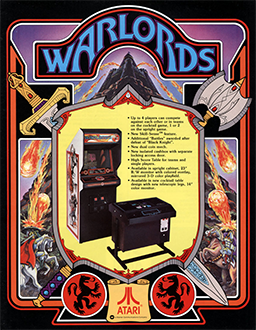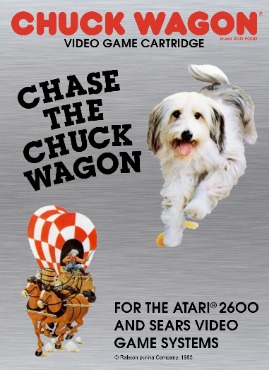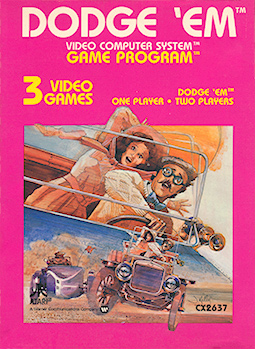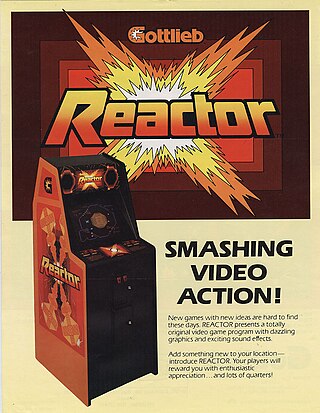
Missile Command is a 1980 shoot 'em up arcade video game developed and published by Atari, Inc. and licensed to Sega for Japanese and European releases. It was designed by Dave Theurer, who also designed Atari's vector graphics game Tempest from the same year. The game was released during the Cold War, and the player uses a trackball to defend six cities from intercontinental ballistic missiles by launching anti-ballistic missiles from three bases.

Alley Cat is a video game created by Bill Williams and published by Synapse Software for Atari 8-bit computers in 1983. The player controls Freddy the Cat, who enters people's homes through open windows to perform various tasks in order to reach his love, Felicia. A port for the IBM PC as a self-booting disk and the IBM PCjr were published in 1984 by IBM. These use four-color CGA graphics.

Mouse Trap is a maze video game developed by Exidy and released in arcades in 1981. It is similar to Pac-Man, with the main character replaced by a mouse, the dots with cheese, the ghosts with cats, and the energizers with bones. After collecting a bone, pressing a button turns the mouse into a dog for a brief period of time. Color-coded doors in the maze can be toggled by pressing a button of the same color. A hawk periodically flies across the maze, unrestricted by walls.

Warlords is an arcade video game released by Atari, Inc. in 1980. The game resembles a combination of Breakout and Quadrapong ; up to four players play the game at the same time, and the "castles" in the four corners of the screen are brick walls that can be broken with a flaming ball.

Pooyan (プーヤン) is a fixed shooter arcade video game released by Konami in Japan in 1982. It was manufactured in North America by Stern Electronics. The player controls "Mama", a pig whose babies have been kidnapped by a group of wolves.

Jr. Pac-Man is an arcade video game developed by General Computer Corporation and released by Bally Midway on August 13, 1983. It has the same gameplay as prior entries in the series, but the maze in Jr. Pac-Man scrolls horizontally and has no escape tunnels. The bonus item which moves around the maze changes dots into a form which slows Jr. Pac-Man as they are being eaten.

Food Fight is an arcade video game developed by General Computer Corporation and released by Atari, Inc. in March 1983. The player guides Charley Chuck, who is trying to eat an ice cream cone before it melts, while avoiding four chefs bent on stopping him. 1,951 arcade cabinets were sold.

The TV Boy, and its successors TV Boy II and Super TV Boy, are handheld TV games sold by many different companies, including Systema, Akor, and NICS, based upon an unlicensed clone of Atari 2600 hardware. They were released around 1992 and three years later, an improved version of the TV Boy 2, the Super TV Boy, was also made by Akor. They were widely available across Europe. In the UK, they were most visibly available through Argos.

Communist Mutants from Space is a fixed shooter video game programmed by Stephen H. Landrum for the Atari 2600 with the Starpath Supercharger cassette accessory. It was published in 1982 by Starpath. The game is similar to Galaxian, adding a variety of gameplay-changing options.

Frog Bog is a 1982 video game by Mattel Electronics for the Intellivision. An Atari 2600 conversion was released later that year as Frogs and Flies. In both games, each player controls a frog sitting on a lily pad, attempting to eat more flies than the other. Frog Bog is similar to the 1978 Sega-Gremlin arcade game Frogs.

Montezuma's Revenge is a platform game for the Atari 8-bit computers, Atari 2600, Atari 5200, Apple II, ColecoVision, Commodore 64, IBM PC, and ZX Spectrum. It was designed and programmed by Robert Jaeger and published by Parker Brothers in 1984. The game's title references a colloquial expression for diarrhea contracted while visiting Mexico.

Alien is a 1982 maze video game for the Atari 2600 published by Fox Video Games. The game has the player control a human moving through the hallways of a space ship avoiding the adult alien and destroying the small alien eggs.

Chase the Chuck Wagon is a 1983 promotional video game written by Mike Schwartz for the Atari 2600 and distributed by Purina. It was available only via mail order by sending in proofs of purchase to Purina. In the 1970s and 1980s, popular television commercials for Purina dog food included a dog chasing a tiny chuckwagon. The gameplay is loosely based on this premise.

Tron: Deadly Discs is a video game for the Intellivision console published by Mattel in 1982. The initial game design was done by Don Daglow, with further design and programming by Steven Sents. It is the first of three Intellivision games based on the Disney motion picture Tron. Mattel released an Atari 2600 version under its M Network label. It was also ported to the Mattel Aquarius.

Dodge 'Em is a driving-themed maze game programmed by Carla Meninsky and published in 1980 by Atari, Inc. for the Atari VCS. Similar to Sega's 1979 Head On arcade game, Dodge 'Em is played on a single screen of four concentric roadways. Sears released the game for the "Sears Video Arcade" as Dodger Cars.

Reactor is an arcade video game released in 1982 by Gottlieb. The object of the game is to cool down the core of a nuclear reactor without being pushed into its walls by swarms of subatomic particles. Reactor was developed by Tim Skelly, who previously designed and programmed a series of vector graphics arcade games for Cinematronics, including Rip Off. It was the first arcade game to credit the developer on the title screen. Reactor was ported to the Atari 2600 by Charlie Heath and published by Parker Brothers the same year as the original.

Eggomania is an action video game released in January 1983 by U.S. Games for the Atari 2600. Similar in design to Kaboom!, which itself is a derivative of the arcade game Avalanche, the objective is to catch eggs in a hat which are thrown by a chicken.
Krull is an Atari 2600 video game based on the 1983 science fantasy film Krull and published in 1983 by Atari, Inc. It was written by Dave Staugas who later ported Millipede to the 2600. Gottlieb manufactured an arcade shooter of the same name in the same year, but it is unrelated to the Atari 2600 cartridge other than the Krull license.

Adventures of Tron is a platform video game produced by Mattel in 1982 for the Atari 2600. It is based on the Disney film Tron. The game was originally intended to be a port of the Intellivision video game Tron: Maze-A-Tron, but it became an original title as development progressed. An Intellivision version of Adventures of Tron was also planned, but it was ultimately cancelled and never saw an official release. Following the loss of the Tron license, the game was re-released as Adventures on GX-12.

Pigs in Space is a three-in-one 1983 video game developed and published by Atari, Inc. for the Atari 2600. It is based on the "Pigs in Space" sketch series on the then-popular television series The Muppet Show. The game is the last in a series of children-friendly games developed by Atari for the Atari 2600. Atari marketed the games as being good for the development of hand-to-eye coordination.




















